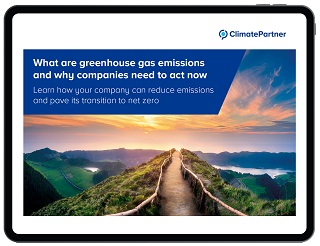Carbon neutral
"Carbon neutral” is a widely used term in climate action communications. It refers to the process of calculating all greenhouse gas emissions associated with a company, product, or service, reducing them as much as possible, and offsetting any remaining emissions by supporting climate projects.
While the approach remains valid and effective, the term itself is facing increased scrutiny from regulators, legal bodies, and the public.
Carbon neutral definition
Carbon neutrality describes a state in which all emissions across the value chain have been calculated and reduced. Any remaining unabated emissions are addressed through the support of certified climate projects, such as reforestation or renewable energy investments.
Standards for carbon neutrality: PAS 2060 and ISO 14068
Two standards define the requirements for carbon accounting, emissions reduction, compensation, and transparent communication.
PAS 2060
Introduced in 2010 by the British Standards Institution (BSI), PAS 2060 was the first internationally recognised standard for carbon neutrality. It outlines a four-step process: calculate emissions, develop a reduction plan, offset remaining emissions, and publish a Qualifying Explanatory Statement (QES).
ISO 14068
Released in November 2023, ISO 14068-1 was the first global ISO standard for carbon neutrality. It builds on PAS 2060 with a stronger emphasis on emissions reduction before offsetting and stricter transparency criteria. PAS 2060 will officially be withdrawn in 2025 and replaced by ISO 14068-1.
Climate projects must also meet high-quality standards. Certifications like the UNFCCC Gold Standard or the Verified Carbon Standard (VCS) ensure emissions reductions are measurable, additional, and permanent.
Carbon neutral does not mean that no emissions are produced, but that they are balanced to net zero through a verifiable process.
How is carbon neutrality different from net zero?
Although often used interchangeably, carbon neutral and net zero are not the same. Carbon neutrality can include short-term offsetting, whereas net zero is a science-based, long-term goal centered on emissions reductions. According to the Science Based Targets initiative (SBTi), achieving net zero means reducing 90–95% of all emissions, with only a small residual amount neutralised through carbon removal technologies or natural carbon sinks.
Carbon neutrality may serve as a milestone on the path to net zero, but it does not replace the need for structural decarbonisation.
A term under scrutiny
“Carbon neutral” has long been used to communicate a company's climate action commitment, including at ClimatePartner. It represents a process that remains valuable and has supported many companies in taking structured climate action.
However, the term is increasingly criticised, particularly when used without a long-term reduction strategy or transparent compensation measures. It can be misleading if it implies no ongoing emissions, or if boundaries and methodologies are unclear.
In response, the EU has introduced the Green Claims Directive and the Empowering Consumers Directive, which will require environmental claims like “carbon neutral” to be clearly substantiated and transparently documented. The final requirements are still being defined.
In this context, clear, honest communication is crucial. This requires credible carbon accounting, a strong focus on emissions reduction, and the use of certified climate projects.
Would you like to make your climate action strategy future-proof?
We help companies define, implement, and communicate credible climate targets.
